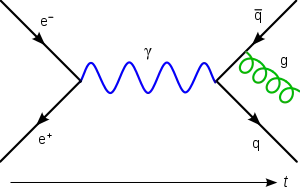Dirac equation in curved spacetime
In mathematical physics, the Dirac equation in curved spacetime generalizes the original Dirac equation to curved space.
| Quantum field theory |
|---|
 |
| History |
It can be written by using vierbein fields and the gravitational spin connection. The vierbein defines a local rest frame, allowing the constant Gamma matrices to act at each spacetime point. In this way, Dirac's equation takes the following form in curved spacetime:[1]
Here eaμ is the vierbein and Dμ is the covariant derivative for fermionic fields, defined as follows
where σab is the commutator of Gamma matrices:
and ωμab are the spin connection components.
The modified Klein–Gordon equation obtained by squaring the operator in the Dirac equation, first found by Erwin Schrödinger as cited by Pollock [2] is given by
where is the Ricci scalar, and is the field strength of . An alternative version of the Dirac equation whose Dirac operator remains the square root of the Laplacian is given by the Dirac–Kähler equation; the price to pay is the loss of Lorentz invariance in curved spacetime.
Note that here Latin indices denote the "Lorentzian" vierbein labels while Greek indices denote manifold coordinate indices.
See also
References
- Lawrie, Ian D. A Unified Grand Tour of Theoretical Physics.
- Pollock, M.D. (2010), On the Dirac equation in curved space-time
- M. Arminjon, F. Reifler (2013). "Equivalent forms of Dirac equations in curved spacetimes and generalized de Broglie relations". Brazilian Journal of Physics. 43 (1–2): 64–77. arXiv:1103.3201. Bibcode:2013BrJPh..43...64A. doi:10.1007/s13538-012-0111-0. S2CID 38235437.
- M.D. Pollock (2010). "on the dirac equation in curved space-time". Acta Physica Polonica B. 41 (8): 1827.
{{cite journal}}: CS1 maint: url-status (link) - J.V. Dongen (2010). Einstein's Unification. Cambridge University Press. p. 117. ISBN 978-0-521-883-467.
- L. Parker, D. Toms (2009). Quantum Field Theory in Curved Spacetime: Quantized Fields and Gravity. Cambridge University Press. p. 227. ISBN 978-0-521-877-879.
- S.A. Fulling (1989). Aspects of Quantum Field Theory in Curved Spacetime. Cambridge University Press. ISBN 0-521-377-684.